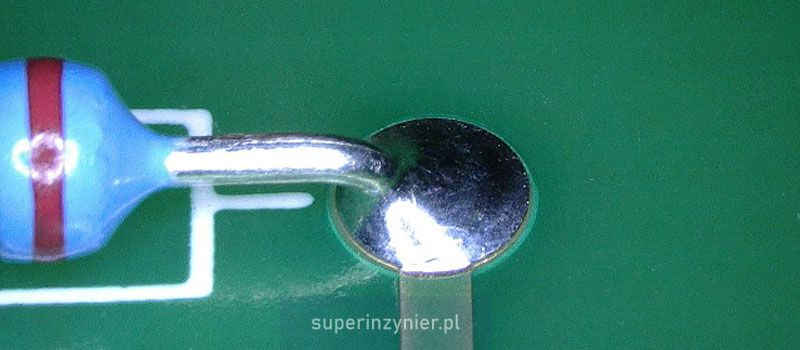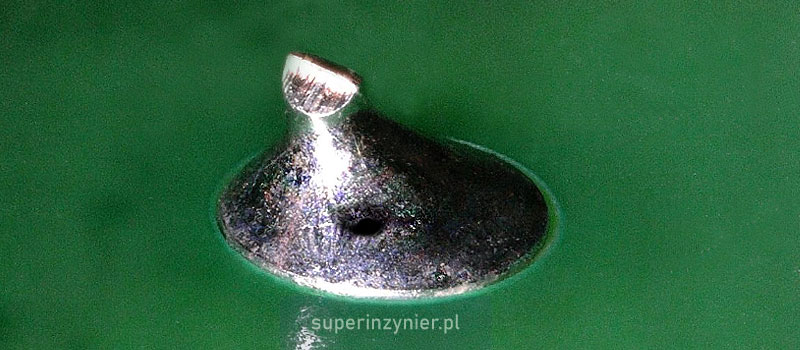IPC: Conditions
IPC standards define the conditions to which a characteristic can be assigned in a bare PCB, PCBA or wire harness. Depending on the standard, there may be slight differences in the name of a given condition (e.g., IPC-A-600 rev.K refers to a defect as "nonconforming" and IPC-A-610H as "defect"), but overall the sense remains the same. The conditions are listed below.
Target condition
The target condition is an "ideal" condition, not always achievable. It is not absolutely required to ensure product reliability.
An example of a target condition is shown in the following photo. The solder covers 100% of the PCB land on the solder destination side. The circumferential wetting of solder to the component lead and PCB land is 360 degrees. Perfect.

The target condition has been formally removed from some IPC standards such as J-STD-001, IPC-A-610, IPC/WHMA-A-620. This condition has been "incorporated" into the acceptable condition. The reason for the formal removal of the target condition is presented in the article: IPC-A-610H: Target condition removed.
Acceptable condition
An acceptable condition is one that does not always look "perfect", but is completely sufficient to maintain the integrity and reliability of the product. An acceptable condition can occur "in series" and there is no reason to make any changes to the product.
An example of acceptable condition for class 1, 2, 3 is shown in the following photo. The solder fills the hole 100%, but does not cover the land on the PCB solder destination side. The original gold finish of the solder land is visible.

A common problem in the electronics industry is correcting an acceptable condition to make it look like the target condition. This is an unnecessary activity that increases the cost of the manufacturing process and often degrades product reliability.
Process indicator condition
The process indicator is a very interesting condition. It is not a defect and at the same time it is not an acceptable condition. It is something "in between". This condition does not affect the form/fit and performance of the product. We can describe the process indicator as follows:
- The result of material- or process-related causes, such as moisture ingress, the result of operators' manual labor, machine variability, etc.
- The number of process indicators should be monitored. If they are "few" then everything is fine. If their number is increasing, it means that "something is going on" in our process and this phenomenon should be corrected.
- Individual process indicators do not need disposition (e.g., repair). This means, for example, that a product delivered to a customer should not be considered defective.
An example of a process indicator for class 2 and 3 is shown in the following photo. A blowhole is visible in the solder alloy. This is usually due to increased moisture in the PCB laminate, and sometimes it is a matter of the PCB heating temperature or the quality of metallization in the PCB bore.

Defect condition
A defect is a condition that can cause:
- Failure to maintain form/fit. This makes it impossible for the product to be further assembled or for the end user to be able to connect the wiring or install the product itself. Simply put, something "doesn't fit" physically.
- Deterioration or loss of product function in the end-use environment. Such a situation will result in device failure (e.g. solder joint breakage, component lead breakage, electrochemical corrosion, etc.).
The defect shall be "dispositioned" that is, the manufacturer shall have to decide what to do with the defect. It may rework, repair, scrap the product or use it "as is".
An example of the defect condition for class 2 and 3 is shown in the following photo. The solder alloy fills the hole less than 75%.

Condition not specified
If there is a condition that is not specified as a process indicator or as a defect, then such a condition is considered acceptable. However, if it is found to adversely affect form/fit or performance, then it is not acceptable.
In some IPC standards, this state is called "Not Established". In this case, if no rejection criteria have been specified, no other rules have been agreed with the customer, then this state is acceptable.
Combined condition (IPC-A-610)
According to IPC-A-610, a combined condition is the simultaneous appearance of several conditions other than defects at a single location. IPC standards do not consider combined conditions, but consider each condition individually.
So if these conditions are considered individually (each "separately") then the product is not defective, but if they occur together then there may be a problem...
The manufacturer should be "vigilant" about such conditions and is responsible for identifying them. The user (customer) is responsible for identifying combined conditions where there is concern about the performance of the product in its use environment.
An example of a combined condition in Class 3 is a THT solder joint with a vertical fill of 75% (acceptable condition) and at the same time the circumferential wetting to the lead on the solder destination side is slightly above 270 degrees (acceptable condition). So can this situation be acceptable, since both characteristics are formally acceptable? Maybe a very high current flows through this connection and the resistance of the connection will be insufficient? Maybe there are significant vibrations and such a connection can break more easily? Can such a condition be acceptable for sure? These are the dilemmas of combined conditions...
Summary
Typical conditions defined by IPC standards are "acceptable condition", "process indicator condition", "defect condition" and sometimes we may encounter "unspecified condition". It should also be noted that "target condition" has been formally removed from some IPC standards and can be said to have been included in acceptable condition. This condition has been "incorporated" into the acceptable condition. I invite you to read the article on: IPC-A-610H: Target condition removed.




